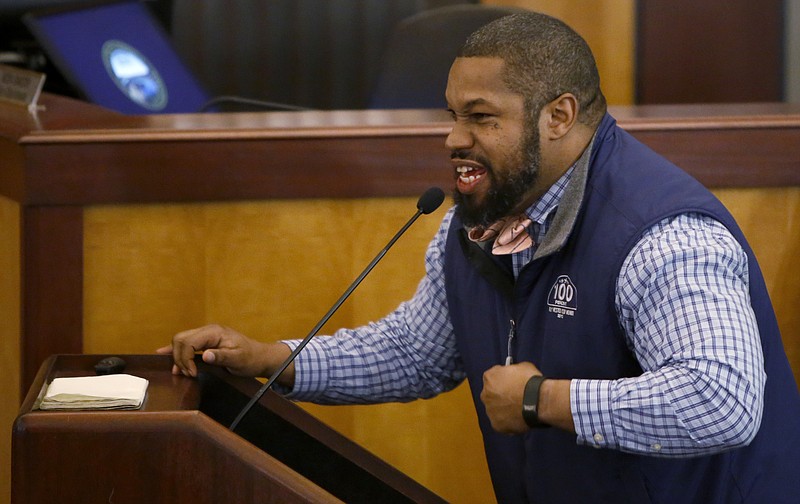Call us skeptical.
The Chattanooga City Council has entered into a one-year, $250,000 contract with consultant Trajectory Changing Solutions to help set and implement a violence intervention strategy.
Violence intervention initiatives, according to the gun violence prevention road map that Mayor Tim Kelly released in July, interrupt cycles of gun violence by directly reaching people at the "highest and most immediate risk and providing them with intensive support, services and opportunities."
If you think you've heard that before, you have. That was almost precisely the strategy of the $1.5 million Violence Reduction Initiative (VRI) introduced in March 2014 by then-Chattanooga Mayor Andy Berke.
The target nearly a decade ago was gang violence. The VRI was based on a policing strategy known as "focused deterrence," which targets violent offenders, offers them the option to seek help through social services but prosecutes them to the fullest extent of the law if they continue to perpetuate violence.
The city's then-public safety coordinator, Paul Smith, said his role at the time was to lead efforts to connect felons and gang members to the jobs, education, counseling and other things needed to induce them to leave the violent life.
However, even the mastermind of the VRI, criminologist David Kennedy from John Jay College of Criminal Justice in New York, said the majority of those targeted were unlikely to accept the help.
"If history is any guide," he said when the initiative was rolled out, "most of them will not end up taking the help they are offered and going back to school and getting jobs. What most of them will do is they will stop acting violently."
That, in itself, would be a worthy goal for Kelly's gun violence prevention road map.
Five years after implementation of the VRI strategy, Berke admitted providing social services was not critical to the initiative's success.
"The idea behind the social services component is that it establishes trust with the community," he said, adding that the lack of the component had not had a direct effect on gun violence in the city.
The VRI's social services arm itself never lived up to its damned-with-faint-praise promise, either.
Only three months after the rollout, the city cut ties with social services provider A Better Tomorrow after its director was arrested on three charges that were later dropped.
It then partnered with Hope for the Inner City, but less than a year later funders began pulling support, according to newspaper archives. A newspaper review of documents showed job numbers and success stories may have been inflated. But the city renewed its contract with the organization.
By 2017, case management for social services had been shifted to Father to the Fatherless (F2F), a training and mentoring program run by Hope for the Inner City. In 2018, the Chattanooga City Council declined to renew its contract with F2F because council members said they did not have enough data to show how the nonprofit had helped provide services for the VRI.
The next year, the Berke administration tried to shift the VRI's social services to focus on mentoring and vulnerable youth, but the council rejected it, saying there were too many unanswered questions and limited evidence of success.
When Berke left office in 2021, the council still had not contracted with a social services provider. But he said gang-member involved shootings fell 67% from a peak in 2016. However, with the exception of 2018, which had an exceptionally low number of shootings, gun violence held steady before climbing during the pandemic-plagued years of 2020 and 2021.
So as to Trajectory Changing Solutions, one can say its quarter million dollar price tag is a sixth of the VRI's cost and that the amount will be drawn from $3.7 million in federal pandemic relief funds (still taxpayer money) the city set aside for public safety and youth engagement initiatives.
The founder of the organization. Norman Livingston Kerr, told the Times Free Press his work will involve helping leaders develop a better understanding of the types of violent incidents that occur here and when they happen, and assess existing programs to see where gaps may exist.
"We want to employ [evidence-based] strategies that we know worked ... such as street outreach, violence interruption work," said Kerr, who oversaw violence reduction efforts in Chicago, one of the most violent cities in the country.
He left the Illinois city in 2021, the year the city experienced its highest homicide rate since the 1990s, to expand his program nationwide. In 2022, the city's homicides fell by more than 100 but were still higher than 2019.
Providing intensive support, services and opportunities did not help many people during the VRI. But it did reduce gang member-involved shootings. If the strategies of Trajectory Changing Solutions can reduce gun violence (whether people use the social services), the money spent would be well worth it. And if the people involved also take advantage of the opportunities, that would be a bonus.
But, for now, we remain skeptical.
